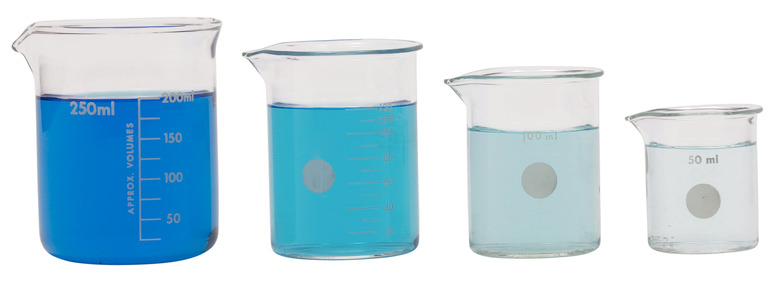How To Calculate Ppm & Ppb
Parts per billion (ppb) and parts per million (ppm) both measure very small concentrations of substances. Scientists convert from ppb to ppm sometimes, because some substances can exert noticeable and even drastic effects on the human body and other biological systems, such as plant life, even in extremely low concentrations.
This means that an element or molecule can be hopelessly outnumbered in its chemical environment and still require careful monitoring. As a result, highly sensitive devices to measure concentration have been developed to ensure the ability to accurately measure very small absolute changes in concentration.
Since a billion is a thousand times a million, or three powers of ten (1 × 103) greater in magnitude than a million, one part _per b_illion (1/1,000,000,000) is one thousand times less than one part per billion 1/1,000,000). But both units crop up in a wealth of situations, typically related to the assurance of public health and safety.
What Are the Units of ppm and ppm?
What Are the Units of ppm and ppm?
When dealing with ppm and ppb values, be sure you know exactly what "parts" are involved. This is because the units can vary from situation to situation and usually depend on the physical state (solid, liquid or gas) or the substance being monitored.
For gases, measuring mass is possible but makes little practical sense. So the parts per million formula for gases within other gases (usually air) is a volume-to-volume relationship, e.g., millionths of a liter (microliters) per liter or μL /L. And ppb may be expressed as nanoliters per liter or nL/L.
For liquids, one part in mass per million or billion volume units is typical, so ppm is often expressed as milligrams per liter; this follows from a milligram (mg) of water having a volume of one microliter (μL), as many liquids are close to this density, and the comparison is in effect a volume-to-volume relationship, as with gases.
The parts per million formula for solids within other solids is a mass-to-mass ratio, e.g., μg/g or mg/kg both represent ppm. (You might experiment with division and multiplication of these quantities using exponents to reinforce the underlying math.)
- For solutions, you could convert ppm to ppb to molarity or conversely if necessary.
Converting from ppb to ppm
Converting from ppb to ppm
The ppm-to-ppb conversion can be tricky if you are used to thinking of a billion as more than a million and significantly so (millionaires get little public attention these days, but billionaires tend to attract plenty). Because ppm and ppb are actually fractions when expressed as numbers, and the "million" and "billion" go in the denominator, so ppm needs to register in your mind as being a thousand times greater in concentration than ppb (regardless of the specific units used).
- Simply, ppm = ppb/1,000, and **ppb =** (1,000)ppm.
Real-World Parts per Billion Examples
Real-World Parts per Billion Examples
A number called the MCL, or maximum contamination level, represents the highest value that can be considered safe. It is often expressed as ppb (or μg/L) or ppm (or mg/L). Many common substances have MCL levels in the general range of one of these units.
The metal arsenic, for example, which can taint fish and other wildlife, was assigned an MCL of 0.010 ppm (or 0.10 mg/L) in the United States in the early 21st century, with the standard taking effect in 2006. Multiplying this value by 1,000 to get ppb, yields 10 ppb (or 10 μg/L). Another substance with potentially hazardous health effects, the element beryllium, has an even lower MCL than does arsenic, 0.04 ppm.
Another way to think of parts per million: If this were the concentration of space aliens in New York City, there would only be about eight of them secreted throughout all five boroughs and 300-plus square miles!
Cite This Article
MLA
Beck, Kevin. "How To Calculate Ppm & Ppb" sciencing.com, https://www.sciencing.com/calculate-ppm-ppb-11415193/. 30 March 2020.
APA
Beck, Kevin. (2020, March 30). How To Calculate Ppm & Ppb. sciencing.com. Retrieved from https://www.sciencing.com/calculate-ppm-ppb-11415193/
Chicago
Beck, Kevin. How To Calculate Ppm & Ppb last modified August 30, 2022. https://www.sciencing.com/calculate-ppm-ppb-11415193/
